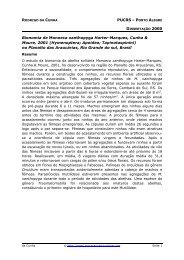Hydrologie - dezentraler Hochwasserschutz
Hydrologie - dezentraler Hochwasserschutz
Hydrologie - dezentraler Hochwasserschutz
Erfolgreiche ePaper selbst erstellen
Machen Sie aus Ihren PDF Publikationen ein blätterbares Flipbook mit unserer einzigartigen Google optimierten e-Paper Software.
OLSCHOWY, G. (1986): Maßnahmen gegen Bodenerosion. Deutscher Rat für Landespflege<br />
Bodenschutz Heft 51, 67-69.<br />
OPPERMANN, J. (1991): Wegeneu- und Ausbauten in den alten Bundesländern. Allgemeine<br />
Forstzeitschrift 26(11), 1350-1352.<br />
ORESKES, N., K. SHRADER-FRECHETTE & K. BELITZ (1994): Verification, validation and<br />
confirmation of numerical models in the earth sciences. Science 263, 641-646.<br />
OTTMÜLLER, M. (2004): Digitale Geländemodellierung aus GPS-Messungen. Dezentraler<br />
<strong>Hochwasserschutz</strong> in kleinen bewaldeten Einzugsgebieten, Schriftenreihe der FH Rottenburg Nr.<br />
20, Hrsg.: R. Irslinger, .<br />
PETERS, N. E., J. FREER & K. J. BEVEN (2001): Modeling hydrologic responses in a small forested<br />
watershed by a new dynamic TOPMODEL (Panola Mountain, Georgia, USA). Freiburger Schriften<br />
zur <strong>Hydrologie</strong>, Band 13, Institut für <strong>Hydrologie</strong> der Universität Freiburg/Br., 318-325.<br />
PETERS, N. E., J. FREER & K. J. BEVEN (2003): Modeling hydrologic responses in a small forested<br />
catchment (Panola Mountain, Georgia, USA): a comparison of the original and a new dynamic<br />
TOPMODEL. Hydrological Processes 17, 345-362.<br />
PLATE, E., A. PFAUD & G. PASCHKE (1986): Auswirkungen der Waldschäden auf die<br />
Wasserwirtschaft aus quantitativer Sicht, Literaturstudie. Institut für <strong>Hydrologie</strong> und<br />
Wasserwirtschaft der Universität Karlsruhe, im Auftrag der Landesanstalt für Umweltschutz Baden-<br />
Württemberg (Institut für Wasser- und Abfallwirtschaft), 179 S.<br />
POPE, J. B. (1946): Investigation in erosion control and reclamation of eroded sandy clay lands of<br />
Texas, Arkansas and Louisiana at the Conservation Experiment Station, Tayler, Texas, 1931-40.<br />
USDA, SCS, Technical Bulletin 916, 76 S.<br />
PRUDHOMME, CH., D. JAKOB & C. SVENSSON (2003): Uncertainty and climate change impact on<br />
the flood regime of small UK catchments. Journal of Hydrology 277, 1-23.<br />
REID, L. M. & T. DUNNE (1984): Sediment production from forest road surfaces. WRR 20(11), 1753-<br />
1761.<br />
REINHART, K. G. (1964): Effect of a commercial clearcutting in West Virginia on overland flow and<br />
storm runoff. Journal of Forestry 62, 167-171.<br />
REMMY, K. (2000): IMA II B 7 Dokumentation von Beispielen der schonenden Bewirtschaftung von<br />
sensiblen Niederschlagsflächen und Bachauen in der Waldwirtschaft. Büro FoNat im Auftrag des<br />
Landesamtes für Wasserwirtschaft Rheinland-Pfalz, 28 S.+Anlagen.<br />
RICE, R. M., B. TILLEY & P. A. DATZMAN (1979): A watershed's response to logging and roads:<br />
South Fork of Caspar Creek, California, 1967-1976. USDA Forest Service, PSW Forest and Range<br />
Experiment Station, USDA Research Paper PSW-146, 12 S. + 4 S. Einführung.<br />
RICE, K. C. & G. M. HORNBERGER (1998): Comparison of hydrochemical tracers to estimate source<br />
contributions to peak flow in a small, forested, headwater catchment. WRR 34(7), 1755-1766.<br />
RICHTER, G. (1998): Bodenerosion als Weltproblem. Bodenerosion, Analyse und Bilanz eines<br />
Umweltproblems, Wissenschaftliche Buchgesellschaft, 230-259.<br />
RICHTER, G. & B. SIEGEL (2002): Vorbeugender <strong>Hochwasserschutz</strong> - eine Aufgabe der<br />
Raumordnung. Wasser & Boden 54(1+2), 47-51.<br />
ROBINSON, M., B. GANNON & M. SCHUCH (1991): A comparison of the hydrology of moorland<br />
under natural conditions, agricultural use and forestry. Hydrological Sciences - Journal 36(6), 565-<br />
577.<br />
ROBINSON, M. (1993a): Collaboration between fields scientists and mathematical modellers -<br />
Physical processes of streamflow generation in small basins. UNESCO/IHP 14 - FRIEND Project<br />
H-5-5, Application of Methods of Analysis Using Regional Data Sets, Volume 1: Hydrological<br />
Studies, A. Gustard, 181-184.<br />
ROBINSON, M. (1993b): Changing ideas regarding storm runoff processes in small basins.<br />
UNESCO/IHP 14 - FRIEND Project H-5-5, Application of Methods of Analysis Using Regional Data<br />
Sets, Volume 3: Inventory of streamflow generation studies, A. Gustard, 3-16.<br />
ROBSON, A., K. BEVEN & C. NEAL (1992): Towards identifying sources of subsurface flow: A<br />
comparison of components identified by a physically based runoff model and those determined by<br />
chemical mixing techniques. Hydrological Processes 6(214), 199-214.<br />
ROMANG, H. (1995): Hydrologische Untersuchungen im Spissibach Leissigen, mit besonderer<br />
Berücksichtigung des Teileinzugsgebietes Buchli. Berner Hydrograph 9, 3-4.<br />
ROTHACHER, J. (1970): Increases in water yield following clear-cut logging in the Pacific Northwest.<br />
WRR 6(2), 653-658.<br />
RUTTER, A. J. (1975): The hydrological cycle in vegetation. Vegetation and the Atmosphere, 1,<br />
Academic Press, 111-154.<br />
SAMBALE, CH. & G. PESCHKE (2001): Experimental analysis of rainfall-runoff events in two small<br />
adjacent mountainous catchments. Freiburger Schriften zur <strong>Hydrologie</strong>, Band 13, Institut für<br />
<strong>Hydrologie</strong> der Universität Freiburg/Br., 148-154.<br />
46



